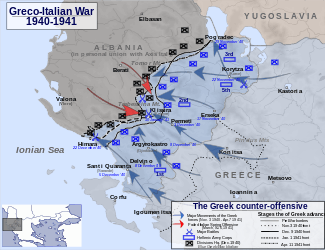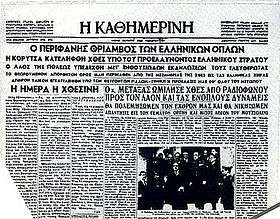Battle of Morava–Ivan
| ||||||||||||||||||||||||||||||
The battle of Morava–Ivan was the first major Greek offensive in the Greco-Italian War of 1940-1941. It took place on the eastern flank of the Greek-Italian front, where the Italian forces had remained on the defensive during the initial Italian invasion toward Epirus. It was a major success for the Greek forces, not only on operational terms, but also as a morale boost, as the breaching of Morava–Ivan line led to the fall of the city of Korçë to Greek hands, and made news internationally.
Prelude
Initial conception
The plans for the offensive had been laid by the Greek General Staff before the start of the war. Following the torpedoing of the Greek cruiser Elli by an Italian submarine on 15 August 1940, the Greek authorities became certain that an Italian invasion was imminent and started to assess the situation. Greek intelligence had revealed fairly accurately the Italian disposition of forces in Albania, which showed that the Italian forces planned to attack towards Epirus while keeping a defensive posture on the Macedonian sector.
The Greek plan was finalised in the second half of September. The Greek forces in North-Western Macedonia would keep a defensive posture, potentially improving the positions with limited attacks in Albanian ground, until the necessary forces arrived. The objective of the offensive was to boost the morale of the Greek forces and the nation in general, as well as to capture the important transportation centre that was Korçë.
28 October – 13 November
The Greek forces available on the sector were the 9th Infantry Division and the 4th Infantry Brigade (soon expanded into the 15th Infantry Division), under the III Army Corps. In the first three days of the war, they were not attacked in any appreciable scale. From 1–6 November, they began their own limited offensives, entering in some places Albania. During these clashes, it was revealed that they faced the Parma, Piemonte and Venezia divisions of the Italian XXVI Corps.
Terrain

The terrain was very favourable for defence, although it afforded little strategic depth. The Greek and Italian positions were separated by the Devoll river valley. North of the valley lay the Morava mountain, a continuation of the Grammos mountains, with a maximum altitude of 1,808 metres (1,977 yd). North of the Morava is the Korçë plateau. The Morava massif provided good defensive positions for the Italians but the lack of depth meant that if the defences on Morava collapsed, they had no option but to abandon Korçë and the Korçë plateau and retreat north to the Kandauian mountains. The upper Devoll valley communicated with the Korçë plateau through the Cangonj pass, which was defined by the Morava on the south and the Ivan mountain on the north. The Ivan mountain is steep and reaches the height of 1,770 metres (1,940 yd). Through the Cangonj pass was a paved road and another hard surfaced road, in the southern part of Morava, crossed the mountain towards Korce.
Prelude
Opposing forces
By 13 November, the Greek forces concentrated for the attack were the 10th, 9th and 15th (the former 4th Βrigade) Divisions, all under III Corps commanded by Lieutenant General Georgios Tsolakoglou, which in turn was subordinate to West Macedonia Army Section under Lt. Gen. Ioannis Pitsikas. The 11th and 13th Divisions were on the march to further reinforce the Greek forces. During the battle, the "K" Group of Divisions (Ομάς Μεραρχιών «Κ») was created under Lt. Gen. Georgios Kosmas, taking the 10th and 11th Divisions under its command.
On the Italian side, there was the XXVI Corps, with the Parma, Piemonte and Venezia Divisions on the front, and the Arezzo Division as the corps reserve. Additional reinforcements in the form of the Alpini Division Tridentina and other Alpini elements began arriving from 13 November, but were committed piece-meal and had little impact.
Plan
The Greek plan was to put the main effort on the left, along the mountainous road through the village Darza, rather through the Cangonj pass, as there were fears that the Italians could use armour through the relatively flat terrain of the Cangonj pass. The Greeks would attack with the 15th Division on the right (toward Cangonj), the 9th in the centre and the 10th on the left. The 15th had the task of approaching the Cangonj pass, between Ivan and Morava, and capturing if possible its western exit. The 9th would attack toward the Morava mountain, coordinating its left flank with the 10th Division. The 10th Division had the task of penetrating the Italian position, through the use of surprise, and if possible flank the Italian positions atop of Morava.
